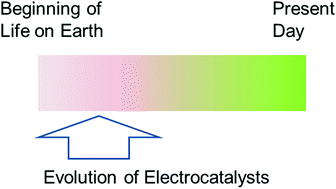The value of enzymes in solar fuels research – efficient electrocatalysts through evolution
Abstract
The reasons for using enzymes as tools for solar fuels research are discussed. Many oxidoreductases, including components of membrane-bound electron-transfer chains in living organisms, are extremely active when directly attached to an electrode, at which they display their inherent catalytic activity as electrical current. Electrocatalytic voltammograms, which show the rate of electron flow at steady-state, provide direct information on enzyme efficiency with regard to optimising use of available energy, a factor that would have driven early evolution. Oxidoreductases have evolved to minimise energy wastage (‘overpotential requirement’) across electron-transport chains where rate and power must be maximised for a given change in Gibbs energy, in order to perform work such as proton pumping. At the elementary level (uncoupled from work output), redox catalysis by many enzymes operates close to the thermodynamically reversible limit. Examples include efficient and selective electrocatalytic reduction of CO2 to CO or formate – reactions that are very challenging at the chemistry level, yet appear almost reversible when catalysed by enzymes. Experiments also reveal the fleeting existence of reversible four-electron O2 reduction and water oxidation by ‘blue’ Cu oxidases, another reaction of great importance in realising a future based on renewable energy. Being aware that such enzymes have evolved to approach perfection, chemists are interested to know the minimal active site structure they would need to synthesise in order to mimic their performance.

- This article is part of the themed collection: Advances in Solar Energy Conversion


 Please wait while we load your content...
Please wait while we load your content...